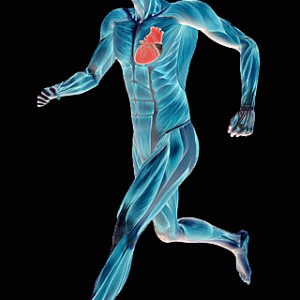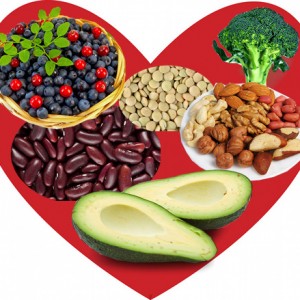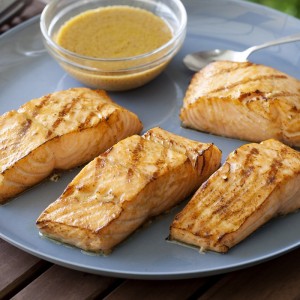It’s a matter of the heart!
It is with a heavy heart that I write the blog entry about nutrition and heart health. Just last week, we lost a friend to a sudden heart attack; he was an active 46-year-old whose passion was coaching youth soccer. While such tragedies are often rooted in genetic causes, it nonetheless highlights the importance of starting heart healthy habits at a young age.
You probably know that both regular exercise and good nutrition are important for keeping your heart healthy, but how much exercise and what types of foods you should eat may be less clear. Aerobic activities like walking, jogging, swimming, biking, climbing stairs or playing sports are especially important for heart health. Strength and stretching exercises are also important, but should be combined with aerobic activities for overall health.
The American Heart Association recommends the following exercise guidelines:
For Overall Cardiovascular Health:
- At least 30 minutes of moderate-intensity aerobic activity at least 5 days per week for a total of 150
Or
- At least 25 minutes of vigorous aerobic activity at least 3 days per week for a total of 75 minutes; or a combination of moderate- and vigorous-intensity aerobic activity
And
- Moderate- to high-intensity muscle-strengthening activity at least 2 days per week for additional health benefits.
In addition, those who want to lower blood pressure and cholesterol, should set a goal of 40 minutes of aerobic exercise of moderate to vigorous intensity 3-4 times a week.
For most people, walking is a great, low-impact way to get started. Keep in mind that any physical activity is better than no physical activity and that it is okay to divide up exercise into smaller 10-15 minute intervals throughout the day!
Nutrition compliments exercise by not only helping you maintain a healthy weight, but also by keeping both cholesterol and blood pressure levels in check. The good news is that the guidelines for a heart healthy diet are much the same as the recommendations for an overall healthy diet. These include eating a diet rich in fruits and vegetables, whole grains, lean proteins and low-fat dairy products. Current dietary guidelines also recommend 2 servings of fish per week, an important source of heart-healthy fats.
A Mediterranean-style diet that includes fruits, vegetables, whole grains, fatty fish, and foods rich in monounsaturated fatty acids (like extra-virgin olive oil and nuts) has become a popular, evidenced based diet for improving heart health. It is reminiscent of the blood pressure reducing DASH diet, used in a multi-center randomized controlled trial (RCT) from August 1993 to July 1997. The DASH diet is also rich in fruits, vegetables, whole grains, and low-fat dairy foods. It includes meat, fish, poultry, nuts and beans, but specifically limits sugar-sweetened foods and beverages, red meat, and added fats. The key components of each of these diets are the emphasis on fruits and vegetables, lean proteins like fish, beans and legumes, and the heart-healthy plantbased fats from olive-oil, nuts and avocado.
Another important consideration for an overall healthy diet is the reduction of both saturated and trans-fats. Saturated fat is found predominantly in animal products, including dairy foods, and should be kept to less than 10% of your overall fat intake. (Note that overall fat intake should be approximately 30-35% of your total diet.) Saturated fats can also be found in some tropical plants and include coconut, palm and palm kernel oil. These plant-based saturated fats are being used to replace their less healthy counterpart, trans fats. Trans fatty acids occur in small amounts naturally, but are largely man-made. Partially hydrogenated vegetable oil, while decreasing in our food supply, is still present in some snack foods, baked goods, icings and flour tortillas. The key message is to read food labels! Anything containing hydrogenated oils is likely to contain some amount of trans fat because current labeling laws allow for 0.5g per serving to be labelled as trans fat-free. So, while one serving may be negligible, an entire package can add up, especially if it is a food you eat regularly.
Whether or not dietary cholesterol increases total cholesterol and LDL, or ‘bad’ cholesterol has been under scrutiny for many years. Guidelines released earlier this month by the U.S. Dietary Guidelines Advisory Committee, support the findings that high cholesterol foods that are also low in saturated fat, including eggs, shrimp, liver and lobster, are unlikely to negatively affect cholesterol. On the other hand, foods that are both high in cholesterol and saturated fat such as sausage or bacon should still be kept to a minimum. These recommendations highlight the fact that cholesterol levels have a strong genetic component; the cholesterol made and processed in your body is to a large extent determined by your genes. What this means is that you can be less concerned about eating an egg or two for breakfast everyday (unless, of course, they are accompanied by high-fat meats or pastries), but should pay more attention to meeting the daily recommendation for dietary fiber which helps bind excess cholesterol and remove it from the body. The current U.S. Dietary Guidelines recommend 25g per day for women and 38g per day for men.
So, how does all of this translate into heart healthy eating? It means you should aim to,
Increase:
- Fruits and Vegetables. Aim for at least 5 cups per day of a variety of colors. Include avocado, a good source of healthy fat and Vitamin E.
- Fatty fish. Salmon, tuna, mackerel, trout and sardines are good sources of hearthealthy, anti-inflammatory Omega-3 fatty acids. They are also one of the few dietary sources of Vitamin D.
- Tree nuts and peanuts. Nuts pack heart healthy fats, protein and fiber into one small bite. Walnuts are especially rich in Omega-3’s.
- Seeds: Sunflower, pumpkin, sesame and the Omega-3, fiber-rich chia seeds and flaxseed provide protein, healthy fat and fiber.
- Beans and peas are high in cholesterol-binding soluble fiber and protein. Like fruits and vegetables, they are also a good source of antioxidants.
- Whole grains. Get at least 3 servings per day. Oats (a good source of soluble fiber), whole wheat, brown rice, wild rice and quinoa are just a few of the countless varieties of whole grains.
- Soy protein from foods like edamame, tofu, and textured vegetable protein (TVP) make for easy meatless meals, and at an intake of 25g per day, may help lower cholesterol.
- Low-sodium flavorings. Herbs and whole spices are not only good sources of antioxidants, but boost flavor without adding salt.
Decrease:
- Fatty and processed meats. Opt for extra-lean ground beef and look for lean cuts of beef and pork like the loin, leg and round.
- High sodium foods. Choosing low-sodium condiments and soups, limiting processed foods and comparing food labels for sodium are simple changes that can make the average recommendation of <2300mg per day of sodium attainable.
- High-fat dairy. Try switching to 1% or skim milk, low-fat yogurt, ice cream, sour cream and cheese. Search for healthier alternatives for cream-based soups and desserts such as this recipe for Creamy Broccoli-Cheese Soup from the March 2015 issue of Cooking Light.
- Saturated and trans fats. Instead, opt for a heart-healthy tub margarine or a ‘light’ butter made with a combination of cream and a heart-healthy oil. Better yet, use olive and canola oil for most of your cooking and baking! Read ingredient lists for sources of partially hydrogenated vegetable oil.
In summary, if you follow current U.S. Dietary Guidelines for a plate half-full of fruits and vegetables, a quarter each of whole grains and lean protein, and 3 servings of low-fat dairy, you are already working to keep your heart healthy! To get you started, here is one of my favorite heart-healthy recipes. Serve with steamed broccoli and brown rice, and the meal comes together quickly!
Ingredients
- side fresh salmon, boned but skin on (about 3 pounds)
For the marinade:
- tablespoons Dijon mustard
- tablespoons good soy sauce
6 tablespoons good olive oil
1/2 teaspoon minced garlic
Directions
Light charcoal briquettes in a grill and brush the grilling rack with oil to keep the salmon from sticking.
While the grill is heating, lay the salmon skin side down on a cutting board and cut it crosswise into 4 equal pieces. Whisk together the mustard, soy sauce, olive oil, and garlic in a small bowl. Drizzle half of the marinade onto the salmon and allow it to sit for 10 minutes.
Place the salmon skin side down on the hot grill; discard the marinade the fish was sitting in. Grill for 4 to 5 minutes, depending on the thickness of the fish. Turn carefully with a wide spatula and grill for another 4 to 5 minutes. The salmon will be slightly raw in the center, but don’t worry; it will keep cooking as it sits.
Transfer the fish to a flat plate, skin side down, and spoon the reserved marinade on top. Allow the fish to rest for 10 minutes. Remove the skin and serve warm, at room temperature, or chilled.
Makes 6 servings.
2001, Barefoot Contessa Parties!, All Rights Reserved
Sources:
“U.S. Advisers Rethink Cholesterol Risk From Foods: Report: MedlinePlus.”U.S
National Library of Medicine. U.S. National Library of Medicine, 10 Feb. 2015. Web. 15 Feb. 2015. <http://www.nlm.nih.gov/medlineplus/news/fullstory_150870.html>.
American Heart Association. “An avocado a day may help keep bad cholesterol at bay.” ScienceDaily. ScienceDaily, 7 January 2015. www.sciencedaily.com/releases/ 2015/01/150107204818.htm, Accessed February 14, 2015.
Original article source: Li Wang, Peter L. Bordi, Jennifer A. Fleming, Alison M. Hill, and
Penny M. Kris‐etherton. Effect of a Moderate Fat Diet With and Without Avocados on Lipoprotein Particle Number, Size and Subclasses in Overweight and Obese Adults: A
Randomized, Controlled Trial. Journal of the American Heart Association, January 2015 DOI: 10.1161/JAHA.114.001355
“American Heart Association Recommendations for Physical Activity in Adults.”
American Heart Association Recommendations for Physical Activity in Adults. N.p.,
Web. 11 Feb. 2015. <http://www.heart.org/HEARTORG/GettingHealthy/PhysicalActivity/ FitnessBasics/American-Heart-Association-Recommendations-for-Physical-Activity-inAdults_UCM_307976_Article.jsp>.
“Dietary Guidelines for Americans.” Dietary Guidelines for Americans. N.p., n.d. Web. 11 Feb. 2015. <http://www.cnpp.usda.gov/DietaryGuidelines>.
“Creamy Broccoli-Cheese Soup Recipe.” MyRecipes.com. N.p., Mar. 2015. Web. 15 Feb. 2015. <http://www.myrecipes.com/recipe/creamy-broccoli-cheese-soup>.
“What Is the FDA-approved Health Claim for Soy Protein?” What Is the FDA-approved Health Claim for Soy Protein? N.p., n.d. Web. 15 Feb. 2015. <http:// www.eatrightpro.org/resource/news-center/in-practice/nutrition-news/what-is-the-fdaapproved-health-claim-for-soy-protein>.
Cunningham, Eleese, RDN. “I Have a Client Who Wants to Follow the Mediterranean Diet: Where Do I Start?” Journal of the Academy of Nutrition and Dietetics 114.8 (2014): 1312. Web. 15 Feb. 2015. <http://www.eatrightpro.org/resource/news-center/in-practice/ nutrition-news/i-have-a-client-who-wants-to-follow-the-mediterranean-diet-where-do-istart>.
“Asian Grilled Salmon Recipe : Ina Garten : Food Network.” Asian Grilled Salmon Recipe : Ina Garten : Food Network. N.p., n.d. Web. 15 Feb. 2015. <http:// www.foodnetwork.com/recipes/ina-garten/asian-grilled-salmon-recipe.html>.
Thank you Brooke P. for helping us find our way to a healthier heart!






